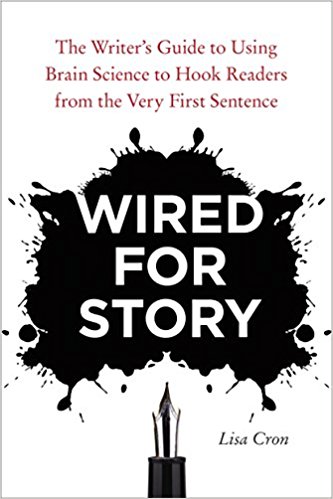January 22, 2018
Worth Waiting For
Reviewed by Anna Husson Isozaki
Wired for Story: The Writer’s Guide to Using Brain Science to Hook Readers from the Very First Sentence. By Lisa Cron. 272 pages. New York: Ten Speed Press, 2012. ISBN-10: 1607742454; ISBN-13: 978-1607742456.
Lisa Cron’s Wired for Story is the writing guide I was searching for during years of buying others, reading them, and setting them on the far backs of bookshelves. Now I know it simply wasn’t published yet. This book is about the neuroscience of our attraction to stories, and how to use our new knowledge to strengthen our work. While good for writing in general, Cron’s book is essential for anyone who has had an idea and the impulse to write, but then thought, “I’m not sure how to write it so others will be interested.”
 Cron’s primary advice is to take relevance and focus in our writing seriously. In keeping with this, she dispenses with the haughty tone (eviscerating other writers as “examples”) or the inane advice (“make index cards of words to increase your vocabulary”) filling other books on writing. Instead, she points out that stopping readers and making them search for a dictionary is not what makes a good writer. We need to intrigue readers, and keep them turning the pages we have written.
Cron’s primary advice is to take relevance and focus in our writing seriously. In keeping with this, she dispenses with the haughty tone (eviscerating other writers as “examples”) or the inane advice (“make index cards of words to increase your vocabulary”) filling other books on writing. Instead, she points out that stopping readers and making them search for a dictionary is not what makes a good writer. We need to intrigue readers, and keep them turning the pages we have written.
Cron’s breezy, entertaining style makes her book a page-turner itself. It is succinct, with a dozen short chapters, each focused on putting to use a particular aspect of the psychology of stories. Her research provides a valuable source for further reading too, with references ranging from Brian Boyd’s seminal On the Origin of Stories through an eclectic collection of writers such as T. S. Eliot and Jennifer Egan.
An encouraging tone also distinguishes this book from others. Even when explaining cheerily that a protagonist has to suffer, in a chapter titled, “What can go wrong, must go wrong—and then some,” Cron’s own writing voice is unfailingly kind. She relates a counseling session with a nice would-be writer in whose (long) novel manuscript nothing of note actually happened: “I asked him how he felt about conflict in his real life. He frowned. ‘I don’t like it,’ he said, tensing. ‘Who does?’” (p. 128)
Cron counters such disastrous avoidance in writing style by showing our attraction to conflict in stories, as in a book-purchasing decision made by literary scholar Stanley Fish when he was short of time in an airport:
He decided to dash into the bookstore and choose a book based solely on its first sentence. Here is the winner, from Elizabeth George’s What Came Before He Shot Her: “Joel Campbell, eleven years old at the time, began his descent into murder with a bus ride.” (p. 18)
Movie stories are also discussed when they demonstrate the points Cron is making. John McClane’s bare feet in Die Hard appear as a sample of skillful setup, with the early, comic relief advice from a fellow airplane traveler leading to repercussions through the film (pp. 191–92). Another movie, “Fracture,” is called upon to illustrate the point that plot, in fact, is not a synonym for “story.” Stories are, Cron writes, about “what the protagonist is forced to learn as he navigates the plot” (p. 31). Wrapping up the book, “Little Miss Sunshine” makes an appearance as an example of a final, inescapable writing point: “There’s no writing; there’s only rewriting” (p. 219). The author of “Little Miss Sunshine,” Michael Arndt, reportedly put his draft through more than a hundred revisions (p. 237).
One forewarning: the only thing that might slow readers down is digging old drafts out of drawers. A friend to whom I recommended the book confessed that she may never actually finish reading it because so many points of advice have prompted her to start again on previously stymied projects.
(With thanks to Michael Pronko of Meiji Gakuin University for suggesting this book on the Liberlit website.)
Originally published in Wordcraft: The SWET Files 2013–2014, pp. 104–106.
